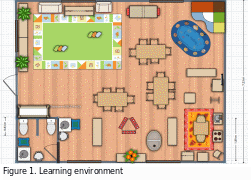Introduction
The learning environment is one of the most important factors for children’s effective learning. It influences learning outcomes and contributes to the socialization of children and the development of basic skills. In addition, the learning environment should be created taking into account the age and capabilities of the child and should be aimed at improving the physical, cognitive, and affective developmental domains. Therefore, this paper will create an example of the organization of space in preschool settings for children aged 2 to 5.
Learning Environment

The learning environment has a significant impact on the learning and development of children. Moreover, it helps teachers to properly organize the learning process to make it more effective for all developmental domains. When designing and planning environments, intentional teachers must consider the many factors that can influence a child’s learning of new information (Estes & Krogh, 2012). Therefore, it should be developed according to the needs and capabilities of each age group of children.
The learning environment in Figure 1 was designed for preschool settings for children aged 2 to 5. Its distinctive features are that it allows varying learner- and teacher-centered teaching strategies. That means that children can make their own decisions about the activities they want, but the teacher can gently guide them and organize the learning process according to the plan (Estes & Krogh, 2012). For example, there is a special carpet for games and a carpet for identifying emotions in the classroom. It helps the teacher understand the children’s moods better while they learn to identify and express their feelings. Moreover, there are opportunities for creativity and motor skills development in the classroom thanks to the sand and water table and art easels. This learning environment also has a kitchen for developing the child’s practical skills and areas for physical activity.
Developmental Domains
Three developmental domains in a child need to be considered when designing a learning space. For physical development, children need regular physical activity and improved motor skills. At two years old, most children already have developed gross motor skills, so the preschool learning environment should be aimed at improving these skills (Estes & Krogh, 2012). That may include washing hands, using a fork, and picking up items. The created learning environment contains a sand and water table, which contributes to fine motor skills development. In addition, a child can develop these skills by performing everyday tasks such as dressing, changing shoes, or eating. Moreover, there is space for children’s physical activity in the classroom.
The cognitive domain is responsible for the child’s intellectual development and the formation of thought processes. According to Piaget’s theory, 2 to 5 years of age corresponds to the preoperational development period (Estes & Krogh, 2012). Children learn to communicate and formulate their thoughts into sentences at this age. Although the child’s vocabulary is relatively small, it is rapidly replenished. Therefore, the task of the teacher is to facilitate this process. The learning environment has a reading zone, where children can collectively read books or organize puppet plays, and an art zone, where children can express their thoughts via art. In addition, the establishment of social ties is facilitated by the placement of tables and the presence of areas for joint games.
The third domain is the affective one, which is responsible for the child’s psychological development and self-awareness. It includes improving interactions and relationships with others through emotional, social, and moral development (Estes & Krogh, 2012). From the age of 2, children learn to recognize their emotions and assess the situation in terms of morality (Estes & Krogh, 2012). That can be facilitated by the presence of a special carpet in the classroom, which makes it easier for the child to express their feelings. In addition, in the mini puppet theater, a teacher can play scenes of different content so that the child learns to distinguish between good and bad.
Developmental Theories
It is possible to use Vygotsky’s developmental theory in this learning environment. According to this theory, learning occurs through interactions with people and objects (Estes & Krogh, 2012). Vygotsky emphasized that education can be developmental only if it is adequate for a given child in form and content. Moreover, according to this theory, stable processes in the child’s development are accompanied by crises (Estes & Krogh, 2012). For example, at age 3, the child self-identifies and begins to socialize. In the created learning environment, this is facilitated by the presence of zones for joint games and tables at which children are placed in groups of 6 people.
Furthermore, children from 2 to 5 years old can also determine their areas of interest. Consequently, the presence of many zones allows the teacher to use different types of activities in the educational process. Most educational processes at this age should playfully take place. For example, a teacher can teach practical skills to children using the kitchenette in the classroom. In addition, the play carpet in the reading zone helps children to get acquainted with new animals and plants.
Conclusion
Thus, the developed learning environment has many zones and activities for children. Items in the classroom help organize the learning process in a playful way, taking into account children’s different interests. In addition, it allows one to vary different teaching strategies for better learning outcomes. The Learning Environment focuses on the development of three key domains, making it optimal for children ages 2 to 5.
Reference
Estes, L.S., & Krogh, S. L. (2012). Pathways to teaching young children: An introduction to early childhood education. Bridgepoint Education, Inc.